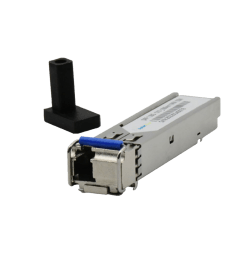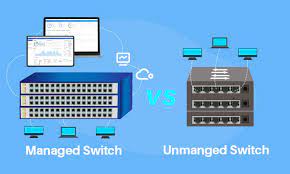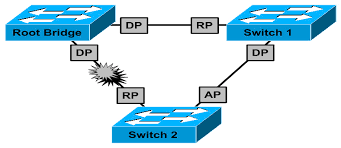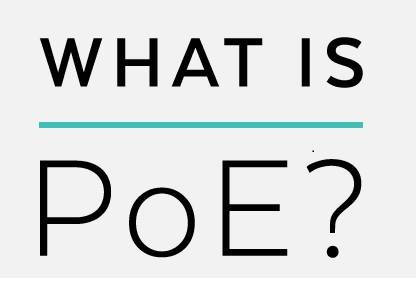Types of sfp models and their applications
Gigabit Ethernet (GE) was introduced in 1999 and due to its remarkable speed, it is gradually replacing Fast Ethernet (FE) in wired LANs. The transmission hardware used to connect GE supported devices is a small compact Form Factor Pluggable (SFP) component. SFP is often called mini-GBIC (gigabit interface converter). Because it is smaller in size and has replaced GBIC modules in most 1GB applications. The original Gigabit Ethernet hardware standard was produced even a year before it was used.
SFP gigabit fiber module types
The SFP fiber optic module can be classified into different versions under Gigabit Ethernet standards and industry accepted standards, including 1000BASE-T, 1000BASE-TX, 1000BASE-SX, 1000BAS-LX, 1000BASE-LX10, 1000BASE-BX10, 1000BASE-LX / LH, 1000BASE-EX and 1000BASE-ZX.
SFP transceivers over copper cabling: 1000BASE-T vs. 1000BASE-TX
It is a 1000BASE-T (IEEE 802.3ab) 1Gb SFP(copper sfp) copper transceiver that transmits GE through a network cable. They make GE a technology because users can use their existing copper cabling infrastructure.
| Technical Specifications | 1000BASE-T | 1000BASE-TX |
|---|---|---|
| Standard | IEEE 802.3ab | TIA/EIA-854 |
| Bandwidth | 1000Mbps | 1000Mbps |
| Transfer type | network cable (Cat5 or higher level), using four bidirectional pairs, each pair supports a data rate of 250Mbps. | network cable (Cat6 or higher level), using two unidirectional pairs (one pair transmit, one receive), each pair supports a data rate of 500Mbps. |
| distance | 100 m (330 ft) | 100 m (330 ft) |
| port | RJ45 | RJ45 |
| Transfer sign | Four-dimensional five-level pulse amplitude modulation (4D-PAM5, 6dB coding). | Ten-Bit Interface (TBI, 8dB/10dB coding). |
Although 1000BASE-TX requires fewer wires for transmission, 1000BASE-T is still more widely used. 1000BASE-T and 1000BASE-TX generally do not interoperate on switches without dual physical layer (PHY) because they use different coding systems.
sfp optical modules
SFP modules that work on optical fiber consist of 1000BASE-SX, 1000BASE-LX and 1000BASE-LX10 standards.
| SFP version | Fiber type | Port | Wavelength | Maximum distance | tip |
|---|---|---|---|---|---|
| 1000BASE-SX | MMF* | LC duplex | 850 nm | FDDI (~ 220 m), OM1 (~ 275 m), OM2 (~ 550 m) | |
| 1000BASE-LX | MMF/SMF** | LC duplex | 1310 nm | MMF (~ 550 m), SMF (~ 5 km) | |
| 1000BASE-LX10 | SMF | LC duplex | 1310 nm | ~ 10 km | |
| 1000BASE-LX/LH | MMF/SMF | LC duplex | 1300 nm/1310 nm | MMF (~ 550 m), SMF (~ 20 km) | Mode conditioning patch cable is required when used with MMF (only FDDI, OM1 and OM2, can not use with higher level MMF). |
| 1000BASE-LH | SMF | LC duplex | 1310 nm/1550 nm | ~ 100 km | |
| 1000BASE-EX | SMF | LC duplex | 1310 nm/1550 nm | ~ 40 km | |
| 1000BASE-ZX | SMF | LC duplex | 1550 nm | ~ 200km |
*MMF = Multimode**SMF = Singlemode Fiber
SFP standard versions are created by manufacturers to meet the gigabit transmission needs of different systems. All are compatible with Multi-Source Agreements (MSAs) to support interoperability between equipment from different vendors.
The difference between sfp optical modules in terms of fiber type
SFPs that work on optical fiber can be classified into different types according to their fiber types. SFP is divided into single-mode and multi-mode SFP, as well as single-core SFP and dual-core SFP.
The difference between single-mode SFP and multi-mode SFP
SFP receivers are divided into single-mode SFP, which works with single-mode fiber, and multi-mode SFP, which works with multi-mode fiber, based on the types of optical fibers that SFP receivers work with.
The difference between single-mode sfp and multi-mode sfp
| Technical Specifications | Multimode SFP | Single mode SFP |
|---|---|---|
| Fiber type | 62.5/125µm or 50/125µm core MMF. | 9/125µm core SMF. |
| Wavelength | 850 nm and 1300 nm. | 1310 nm and 1550 nm |
| Color code | Black hook | Blue hook for 1310 and yellow hook for 1550 nm |
| Module handle color | Orange hook OM1 & OM2. | Yellow for single mode fiber |
| Transmission distance | A short distance of 100 to 500 meters | 2 km, 10 km, 20 km, 40 km, 80 km, 100 km and 200 km. |
| Price | The price is lower than single mode | The price is higher than Multimode |
single-blind sfp and double-blind sfp
Apart from the above-mentioned SFP modules that use Zukor for duplex transmission (one transmit and receive separately), there are also SFP modules that use only a single fiber for transmission (both send and receive). do The latter are simple SFPs (Simplex SFPs) or more commonly known as bidirectional SFPs (BiDi), which are equipped with a WDM coupler/diplexer. The most used wavelength pairs of BiDi SFPs are 1310nm / 1550nm, 1310nm / 1490nm and 1510nm / 1590nm. And the transmission distances when using different wavelengths vary from 10 km to 160 km. Simplex SFP and duplex SFP are very easy to distinguish from each other.

bidi sfp
All receiver SFP modules must be used in pairs. For two-way SFPs on both sides, we need to connect two SFPs with the same wavelength. For example, two 850nm SFPs or two 1310nm SFPs. However, for simplex / BiDi SFPs, we need to use two SFPs that have opposite wavelengths for transmitter and receiver, which has a more detailed introduction in the article Brief Introduction of BiDi SFP Transceiver.
wdm sfp modules with different wavelengths
As an advanced technology that allows the simultaneous transmission of multiple signals on a single fiber, it is called wavelength division multiplexing (WDM) by telecommunication systems in long distance transmission, either DWDM (dense WDM) or CWDM ( coarse WDM) is used. In these systems, SFP receiver lasers are selected with precise wavelengths at close range.

CWDM SFP
CWDM SFP and DWDM SFP are both connected with single-mode LC duplex fiber cables, but their differences outweigh the similarities. In general, when a customer needs a number of channels up to 18 channels, it is more cost-effective to deploy CWDM SFP versus DWDM SFP. For information on how to choose CWDM SFP+ and DWDM SFP+, you can read the article: Everything you need to know before buying a CWDM and DWDM SFP+ transceiver.
| Technical Specifications | CWDM SFP | DWDM SFP |
|---|---|---|
| wavelength interval | Up to 18 wavelengths from 1270 nm to 1610 nm with a 20nm spacing, i.e. 1270 nm, 1290 nm, 1310 nm, 1330 nm… | Up to 45 wavelengths ( Channel 17 to Channel 61 according to ITU) of C Band (1525 nm to 1565 nm) or L Band (1570 nm to 1610 nm) with a 0.8nm spacing. |
| Laser modulation | Electronic tuning uncooled laser. | Cooling laser which adopts temperature tuning enables DWDM SFP better performance, higher safety and longer life span. |
| Transmission distance | Up to 120 km, typically 80 km. | Up to 80 km or 200 km. |
| Application type | Gigabit Ethernet, Fibre Channel (FC), Metro Access Network, Point-to-Point Network, Synchronous Optical Network (SONET), SDH (Synchronous Digital Hierarchy). | Long distance DWDM SONET/SDH transmission, Gigabit Ethernet, Fibre Channel, Metro Network. |
| to be economical | Passive equipment that uses no electrical power. Much lower cost per channel than DWDM. Scalability to grow the fiber capacity as needed with little or no increased cost. Protocol transparent. Ease of use. | Up to 32 channels can be done passively. Up to 160 channels with an active solution. Active solutions involve optical amplifiers to achieve longer distances. |
| Disadvantages | 18 channels may not be enough. Passive equipment that has no management capabilities. | DWDM solutions are quite expensive. Active solutions require a lot of set-up and maintenance expense. Very little scalability for deployments under 32 channels. |
SFP modules for high quality video transmission
3G-SDI (serial digital interface) SFP video transmitters and receivers are designed to meet the needs of standard video transmission in high definition (HD) environment. The main difference between video SFPs and normal SFPs is that video transmission is unidirectional. Therefore, the film SFP can have two optical transmitters, two optical receivers, a single transmitter, a single receiver, or an optical transmitter and a receiver. Similar to conventional SFP receivers, 3G-SDI video SFPs can be multi-mode, single-mode, BiDi or CWDM transmitters and receivers with different wavelengths and can have different distances.
PON SFP modules FTTx networks
Passive optical networking is the key technology used in fiber-based access networks (FTTx). PON SFP receivers are used in the optical line terminal (OLT) in the central office and the optical network terminal / unit (ONT / ONU) in the shared location. The difference between PON SFP and other SFP receivers is that OLT SFP and ONT SFP are not used in pairs, instead OLT SFP must communicate with up to 32 or 64 ONT SFP. Generally, GPON SFP consists of two types: Class B+ and Class C+. Here you can see their differences.
| Module type | Class B+ | Class C+ | ||
|---|---|---|---|---|
| Ports | Tx power | Max. Rx sensitivity | Tx power | Max. Rx sensitivity |
| GPON OLT SFP | 1.5-5 dBm | -28 dBm | 3-7 dBm | -32 dBm |
| OLT SFP Operation Wavelength | 1480-1500 nm | 1260-1360 nm | 1480-1500 nm | 1290-1330 nm |
| GPON ONT SFP | 0.5-5 dBm | -27 dBm | 0.5-5 dBm | -30 dBm |
| ONT SFP Operation Wavelength | 1260-1360 nm | 1480-1500 nm | 1290-1330 nm | 1480-1500 nm |
Growth to higher speed: from SFP to SFP+ and SFP28
The trend of higher speed and bandwidth is unstoppable, from Fast Ethernet to Gigabit Ethernet and then to 10 Gigabit Ethernet and 25 Gigabit Ethernet. At the same time, new devices are released for data transmission, SFP + for 10 Gb and SFP28 for 25 Gb Ethernet. The most obvious difference between them is the data rate, while they all use the same form factor packaging. The difference between SFP vs SFP+ vs SFP28 is as follows.
| Specifications | SFP | SFP+ | SFP28 |
|---|---|---|---|
| Bandwidth | 1.25G 2.5G/3G/4.25G | 6G/8.5G/10G | 25G |
| type | Single-mode/Multimode Simplex/Duplex CWDM/DWDM | Single-mode/Multimode Simplex/Duplex CWDM/DWDM | Single-mode/Multimode |
| distance | 100 m/300 m/2 km/ 10 km/15 km/ 20 km/40 km/ 60 km/80 km/ 100 km/120 km/ 150 km/200km | 220 m/300 m/ 2 km/10 km/ 20 km/40 km/ 60 km/80 km/120km | 100 m/10 km |
| Wavelength | 850 nm 1310 nm/1490 nm/1550 nm 1270 nm-1610 nm ITU Channel 17 ~ Channel 61 | 850 nm 1310 nm/1490 nm/1550 nm 1270 nm-1610 nm ITU Channel 17 ~ Channel 61 | 850 nm/1310 nm |
Where can we get quality sfp module compatible with our device?
Regardless of specific switches/routers/servers, it will be difficult to tell which SFP is suitable when used with different types of SFP modules. But you can deal with these problems when choosing Arivant. Not only all types of SFP can be provided, but also with free technical support for the communication of any device that they need. Each SFP module is checked for compatibility and quality before it is sent to you. For your questions about SFP, contact the Arivant technical unit.









